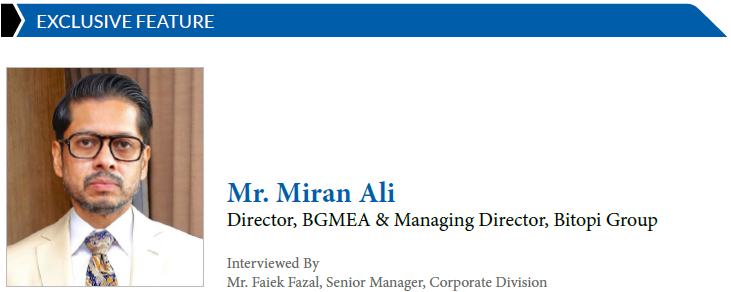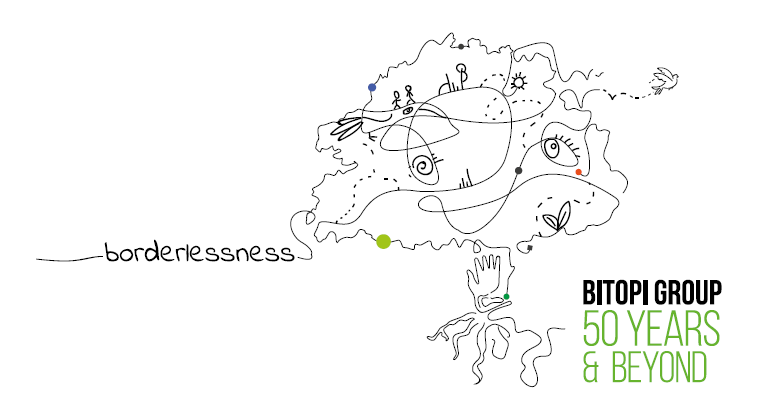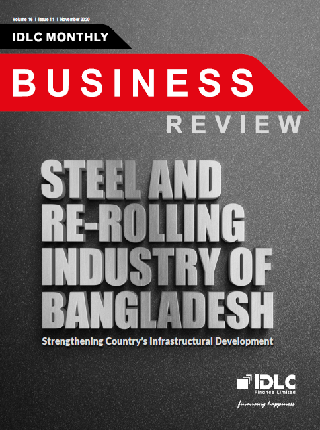
Mr. Miran Ali, Director, BGMEA & Managing Director, Bitopi Group
Mr. Faiek Fazal, Senior Manager, Corporate Division
MBR: Please share with us your opinion regarding the impact of Covid-19 on the RMG sector of Bangladesh. What are your suggestions for the struggling industry players?
Mr. Miran Ali: The Covid situation in Bangladesh is very much under control right now. However, as we are an export-oriented industry, one thing that concerns us more, is the situation of the selling countries. Our key markets are Western Europe, Eastern Europe, North America, Australia etc. The COVID-19 situation in each of these markets is different. Moreover, within these markets the COVID-19 situation also varies. For instance, even if there is a complete lockdown going on in any market, the essential shops continue to operate as they sell foods, clothes, medicines etc. Thus, supermarkets like Walmart, Target, Tesco, Aldi, Kmart etc were never shut down during the lockdown. Fortunately, some of the biggest clients of Bangladesh are retailers who are called big box retailers. if any company’s export basket consists of such essential markets then they will continue buying instead of lockdown. The amount can be less than before, but the buying will not completely stop. On the other hand, if the export basket contains retailers, who only sell through physical stores in a single location or single geographic area then the sufferings will be more than the essential market sellers. However, if the retailer is selling the products in different countries through both online and physical stores then the demand scenario will be better. It is because even if some countries are under lock down others are open. On the other hand, online platform is still open for the locked down countries. We have also observed that since Covid-19 is a seasonal flu if we are selling to the southern hemisphere by definition the southern hemisphere will have a low infection situation whereas the northern hemisphere will have a high infection situation. Which means, when the UK or Europe is moving towards lockdown, Australia might be open. Thus, we need to diversify our geographical locations and also the kind of customers that we supply to. We also have ensured
the clients that we are more Omni channel, so that, they themselves can be more resilient.
MBR: What do you think are the primary reasons why RMG companies are preferring to employ expatriates over local professionals in the RMG industry?
Mr. Miran Ali: I believe there is a misrepresentation regarding the presence of expatriates particularly in the RMG sector. Such misunderstanding has arisen from the fact that in the past, majority of the senior position used to be held by the expatriates. To give our own example, 3 years ago we had 35 expatriates working for us who were Srilankan, Indian, Pakistani British, Irish, German, Turkish etc. Interestingly, from 35 we have come down to 6 to 8 expatriates who are basically working in the technical sector.
MBR: What are some of the key roles within a large RMG company, where expatriates are hired? And what are the major required skillsets and personality traits assessed for these roles?
Mr. Miran Ali: The positions where we still have expatriates are basically 3 key positions. One of which is design and development. The issue here is, it is almost impossible to run a design and development studio where you are doing original collections and selling to different clients around the globe without an expatriate because ultimately the end buyers are not from Bangladesh. We are selling to customers in USA, UK, and Europe or in some other places. In order to understand the market, it is required to have an expatriate to handle the department. In our case, we have a Spanish national running our design studio however, everyone under her is locals. The other area is the head of operations. This industry has been in Bangladesh for last 25 years. The industry has existed in Bangladesh in its present form technically since about the early eighties but practically in its modern form, it only started in late nineties or early two thousands. Moreover, the industry also went through major cycles of evolution over the last decade. The industry today is very different from the industry in 2000 or even in 2010. Thus, we can say that the industry now is nothing like the industry which existed in the nineties. So, what happened in the early years of the industry was that there was a reluctance in the part of educated young men and women to enter into the garments industry because there was a misperception or low perception regarding employment in this sector. As a result, in the initial years until recently it was quite difficult to get local talents on board. For example, if IDLC puts an advertisement tomorrow for management trainee where no experience is required, you probably will get 40,000 applications out of which 25% are probably women. If I put the same advertisement, I will probably get 700 applications which was 200 before. Among the 700 applicants there will be only 15 to 20 female applicants. That means, there is a reluctance in local graduates in factory management. However, the scenario is not same for Sri Lanka or India. Although India has little mass manufacturing as compared to us, it does have people who have grown up or worked in multiple countries in manufacturing operations management. The other area is wet processing or washing. Washing is a relatively new operation in Bangladesh, it has grown bigger over the past 10 years. In our factory, we used to have 6 Turkish nationals running the washing plant but over the last two years we have completed the transition and now it is completely run by the locals.
MBR: What do you think is the perceived economic cost of hiring expatriates? Do the costs justify their value addition?
Miran Ali: As I was saying earlier, the perception that there are a lot of expatriates in the RMG sector of the country is a misperception. As a total number of employees, the number is not even a statistical percentage but as management employees the number is statistical percentage. However, the number is very insignificant and constantly declining. As a matter of fact, there is no big out flow of funds because of the expatriates as they are also very high taxpayers. The minimum wage to hire an expatriate is USD 1500 per month and they must pay tax on this. Thus, each expatiates who are working in this sector are contributing to training our people and paying high taxes which is duly assessed by the government.
MBR: What is your opinion about the presence of young graduates in the industry now a days?
Mr. Miran Ali: The number of expatriates in the garments industry is at a constant decline. However, it will take another 10 years for the number to be even more insignificant. Two of our factories are now run by management trainees who joined us 16 or 17 years ago. One third of another factory is now run by management trainees who has now come up through the organogram. However, if we talk about overall operation, it is still managed by expatriates. It might take another 10 years for the unit heads to take over that position.

MBR: What type of initiatives do you suggest that educational institutions as well as BGMEA should undertake in order to:
a. Enhance the attractiveness of the sector to talented local graduates
b. Improve the employability of local graduates by closing the knowledge and skill gap between them and the expatriates?
Mr. Miran Ali: Every year the number of fresh graduates who are interested in the RMG sectors and specifically in the factory positions is improving day by day. These people who are coming into the industry will eventually take the positions of all the expatriates in future. In order to make this transition faster and easier the industry can provide curriculums which are more technically enriched and more maths and statistics oriented. More textile engineering and
industrial engineering-based curriculums are needed for this sector. BGMEA is working with the government with several initiatives. It also tries to co ordinate with different NGOs and donor organizations to make sure the technical and practical education given to the young graduates are relevant to the industry. For that we try to give feedback and interact with universities like BUET, BRAC etc. to make sure that the faculties also understand what the industry needs. There are still rooms for improvement here. The interaction should be far more than what we do now, but it is still a very positive imitative for improvement.
MBR: What kind of impact is COVID-19 expected to have on the attractiveness of Bangladesh as a workplace destination for expatriates?
Mr. Miran Ali: In the garments industry, I do not know of any expatriate who is currently not in Bangladesh. All the expatriates working for this industry are in Bangladesh. If we consider any big factory in India the number of expatriates is much higher than Bangladesh. On the other hand, in Jordan or Ethiopia we might even find 100% expatriates run factories with no local management at all. We do not have such situation. In Bangladesh if a factory consists of 2500 people, we may find only 1 expat which is a very insignificant number. Moreover, Bangladesh is doing far better than any other country in terms of our response to covid situation as well. Thus, the expats are very comfortable in working here. It is not the case like Cambodia or Myanmar. Myanmar has 20% more expats than us.

STEEL & RE-ROLLING INDUSTRY OF BANGLADESH: STRENGTHENING COUNTRY’S INFRASTRUCTURAL DEVELOPMENT
Steel and Re-Rolling industry: fast paced recovery from pandemic on the cards
The Steel and Re-rolling industry, one of the prominent growth drivers of Bangladesh, has had its fair share of hit by the Covid-19 pandemic. This has been reflected on numbers as world crude steel production recorded a 3.2% decline compared to figures recorded in the same time period last year. As a developing nation with increased focus on to infrastructural development and lined up mega projects, Bangladesh sees massive growth potential in the Steel industry. With a market size of around BDT 450 billion the local Steel market employs nearly 1 (one) million people directly or indirectly across the country. The market has been growing at a rate of 15%- 20% for the past 2 years and contributes largely to the country’s GDP. However, the market for steel is turning into a perfectly competitive one from an oligopolistic structure as small players are now gaining efficiency and reaching competitive levels of their larger peers such as AKS, BSRM, KSRM etc. With the growth of the smaller companies, it is safe to say that the challenges that come with surviving in the Steel industry – such as, abundant supply of power and gas, availability of raw materials etc. are being well taken care of.
The Steel industry strategically runs on overcapacity. It is seen that the utilization is around 75% of total capacity which came down to 40% due to the pandemic wave. The prices of raw materials and finished goods are also seen to fall. However, as a resilient nation, Bangladesh is adapting fast to the new challenges that came with the pandemic. And, as we look towards a new normal, companies in the Steel industry must work in collaboration with regulators in order to sustain the growth and maintain the level of efficiency reached prior to the pandemic.
Sushmita Saha
Assistant Manager
IDLC Finance Limited